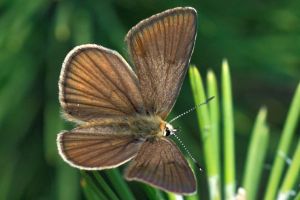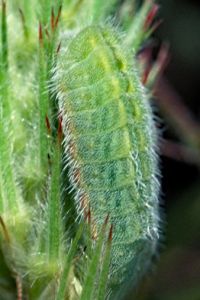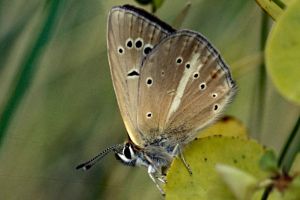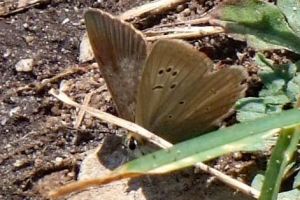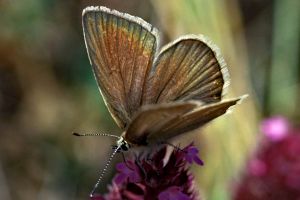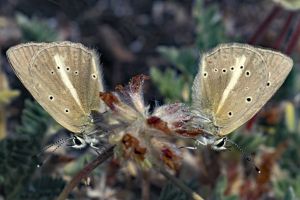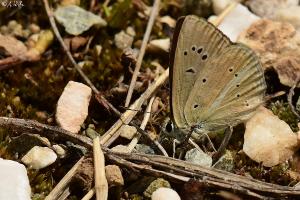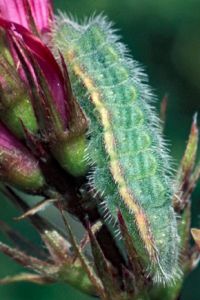

 +2Kontinente:EU
+2Kontinente:EU1. Lebendfotos
1.1. Falter
1.2. Ausgewachsene Raupe
2. Weitere Informationen
2.1. Andere Kombinationen
- Agrodiaetus nephohiptamenos Brown & Coutsis, 1978 [Originalkombination]
2.2. Taxonomie und Faunistik
Die Arten um Polyommatus ripartii werden von den verschiedenen Autoren völlig unterschiedlich bewertet. Ein Abschluss der Diskussionen ist hier nicht in Sicht.
Kudrna et al. (2011) orientieren sich an Vila et al. (2010) und akzeptieren nur P. violetae und P. fabressei als eigenständige Arten neben P. ripartii. P. exuberans, P. rippertii, P. galloi und P. nephohiptamenos werden alle als jüngere subjektive Synonyme zu P. ripartii betrachtet.
Tshikolovets (2011) orientiert sich ebenfalls an Vila et al. (2010), akzeptiert neben P. violetae und P. fabressei aber auch P. nephohiptamenos als eigenständige Art neben P. ripartii. Die Taxa agenjoi (Nord-Spanien), rippertii (Nord-Italien, Südost-Frankreich), budashkini (Ukraine: Halbinsel Krim), pelopi (Griechenland: Peloponnes), galloi (Süd-Italien) und paralcestis (Türkei, Transkaukasien, Kaukasus) werden als Unterarten von P. ripartii behandelt, exuberans dabei als Synonym zu Subspecies rippertii gestellt.
Die Fauna Europaea [Fauna Europaea, Version 2.4, last update 27 january 2011] akzeptiert neben P. violetae und P. fabressei sowohl P. nephohiptamenos als auch P. galloi als eigenständige Arten neben P. ripartii. pelopi und exuberans werden als Synonyme zu P. ripartii gestellt, allerdings mit dem Hinweis, dass sie von einigen Autoren als Unterarten oder auch Arten gewertet werden, budashkini wird als Unterart von P. ripartii angesehen, ebenfalls mit dem Hinweis, dass manche Autoren darin eine Art sehen. agenjoi wird als Synonym zu P. fabressei gestellt.
(Autor: Erwin Rennwald)
2.3. Typenmaterial
Brown & Coutsis (1978: 207): “Holotype ♂ (forewing length 17 mm), mountains of NE. Greece, 1800 m, 30.vii.1977, J. Brown leg. et coll.
Allotype ♀ (forewing length 14.5 mm) mountains of NE. Greece, 1800 m, 30.vii.1977, J. Brown leg. et coll.
Paratypes. Data for holotype except 12 ♂, 6 ♀, 1600-1900 m. 27-30.vii.1977, J. Brown leg. et coll.; 12 ♂, 3 ♀, 1600-1800 m, 27.-30.vii.1977, J. G. Coutsis leg. et coll. (♂ forewing lengths 14.0-17.5 mm; ♀ forewing lengths 14-16 mm).”
2.4. Literatur
- Erstbeschreibung: Brown, J. & J. G. Coutsis (1978): Two newly discovered lycaenid butterflies (Lepidoptera: Lycaenidae) from Greece, with notes on allied species. — Entomologist's Gazette 29 (4): 201-213.
- Eckweiler, W. & G. C. Bozano (2016): Guide to the Butterflies of the Palaearctic Region. Lycaenidae part IV: 1-132. Milano (Omnes Artes).
- Kudrna, O., Harpke, A., Lux, K., Pennerstorfer, J., Schweiger, O., Settele, J. & M. Wiemers (2011): Distribution atlas of butterflies in Europe. — 576 S.; Halle a.d. Saale (Gesellschaft für Schmetterlingsschutz e.V.)
- Tshikolovets, V. V. (2011): Butterflies of Europe & the Mediterranean area. — 544 S.: Pardubice, Czech Republik (Tshikolovets Puplications).
- Vila, R., Lukhtanov, V. A., Talavera, G., Gil-T., F. & N. E. Pierce (2010): How common are dot-like distributions? Taxonomical oversplitting in western European Agrodiaetus (Lepidoptera: Lycaenidae) revealed by chromosomal and molecular markers. — Biological Journal of the Linnean Society 101: 130–154 [Abstract auf onlinelibrary.wiley.com].



